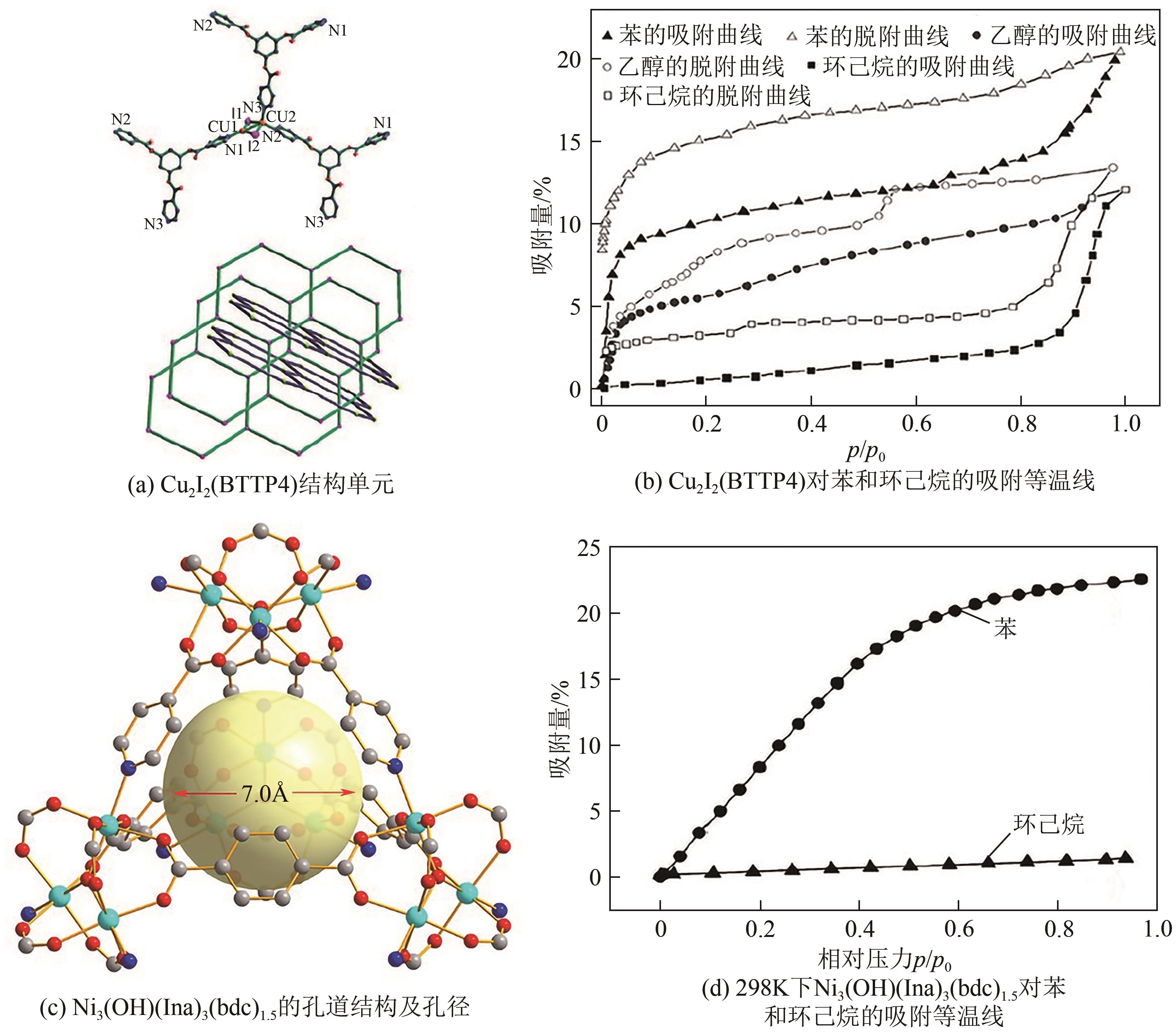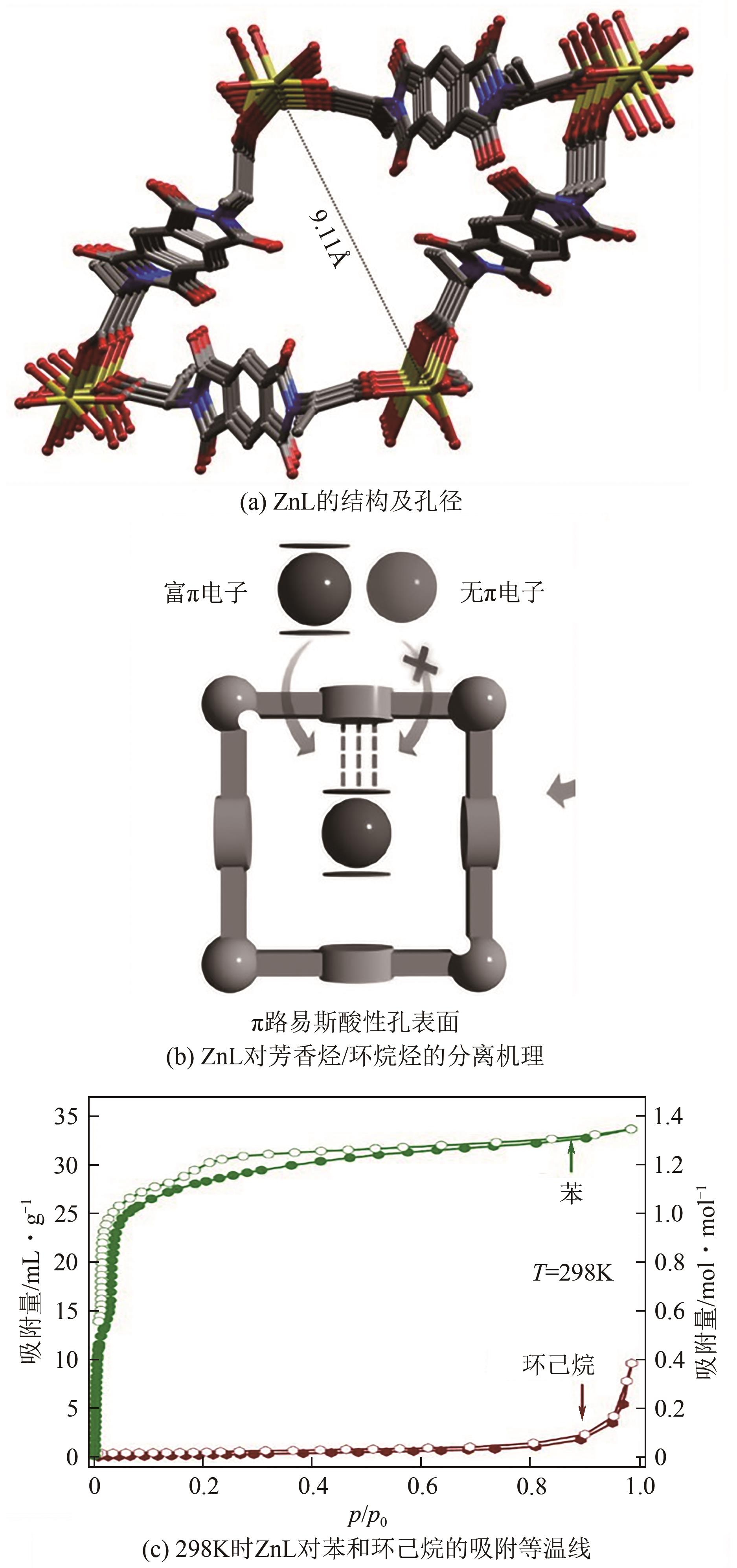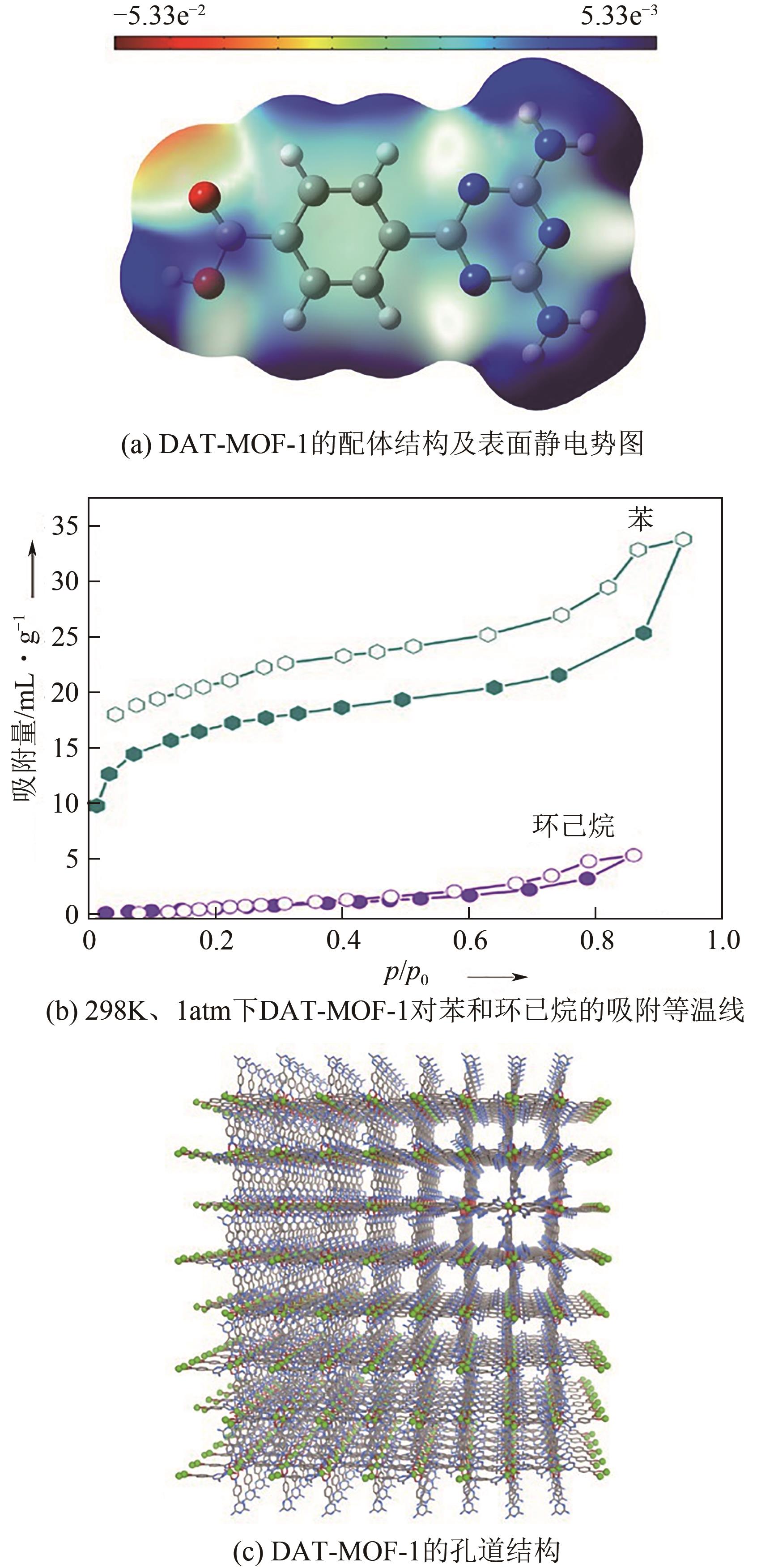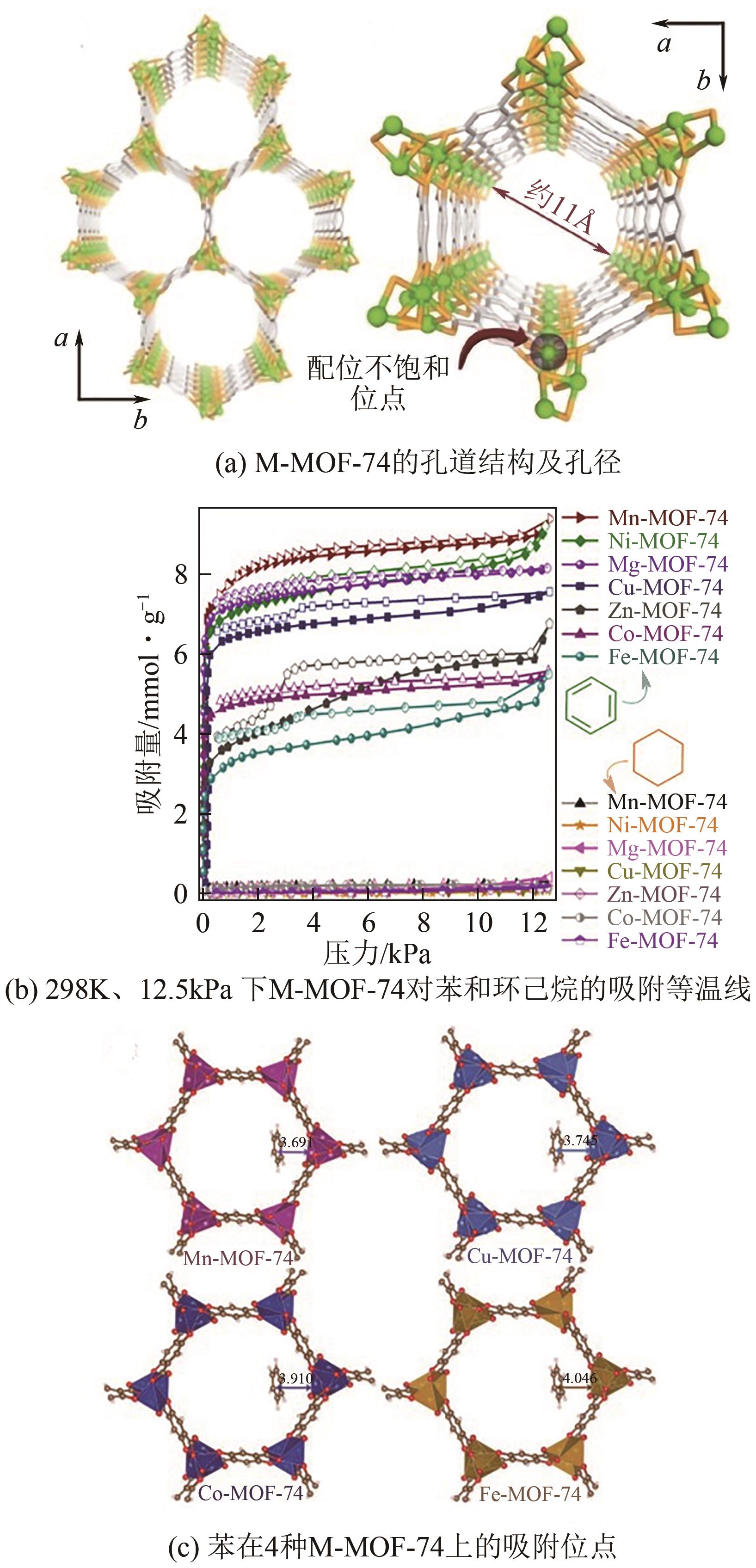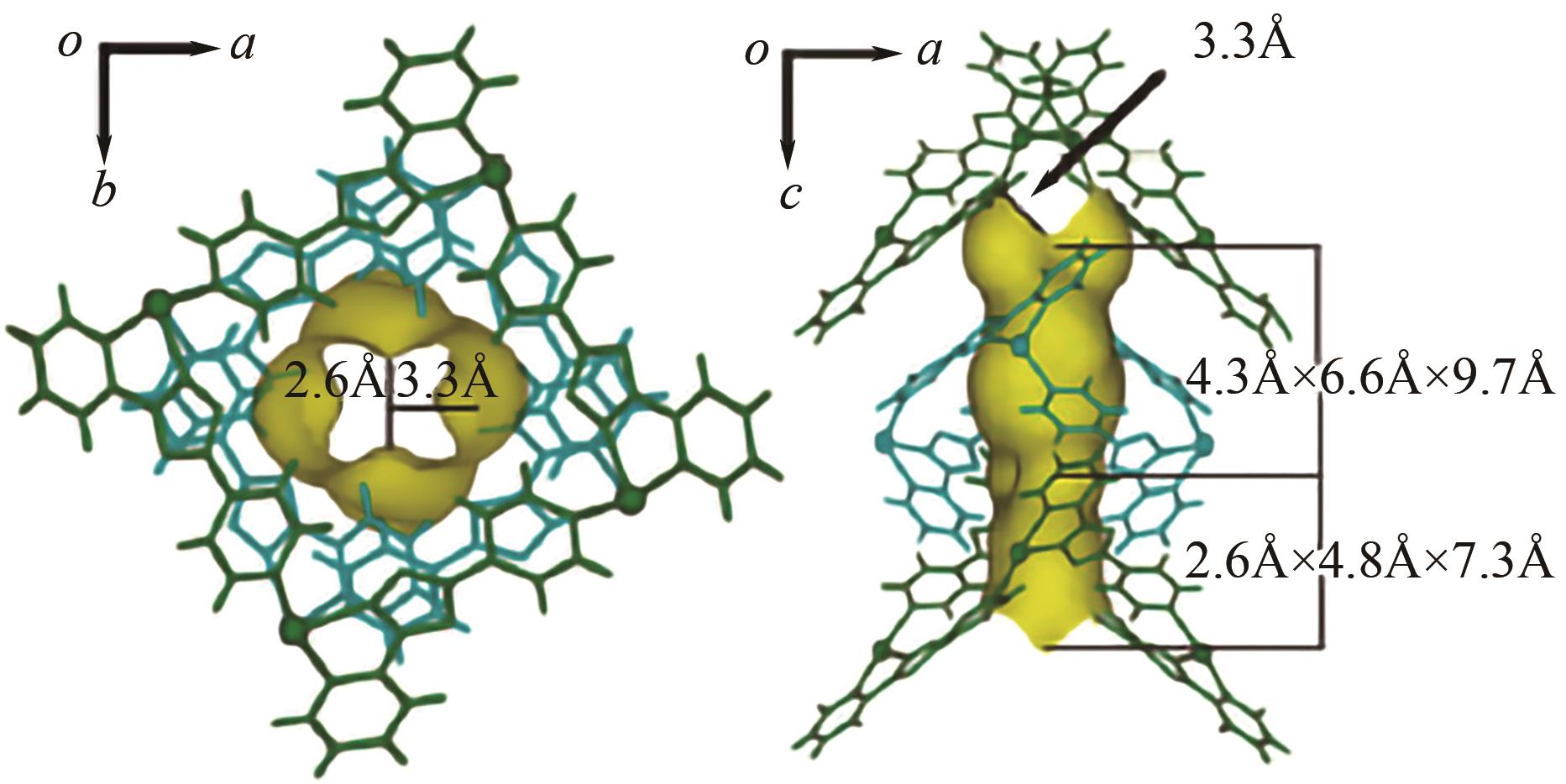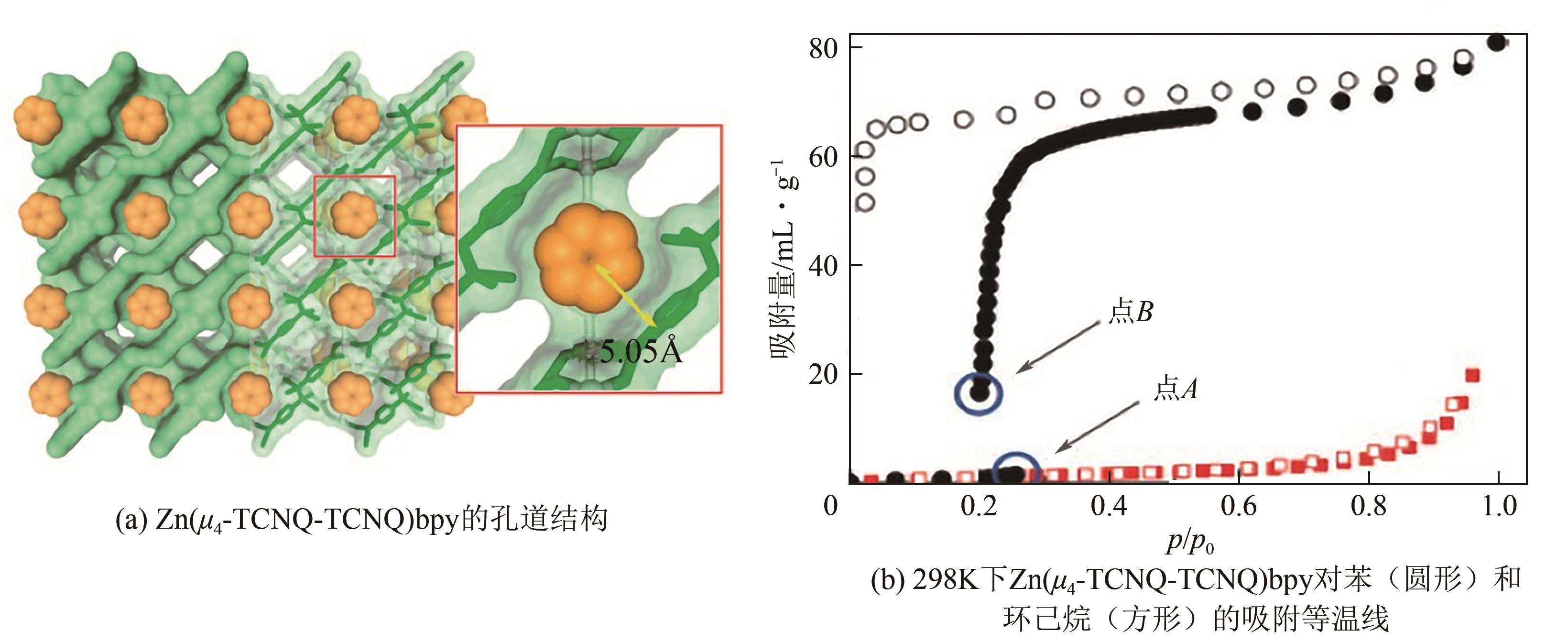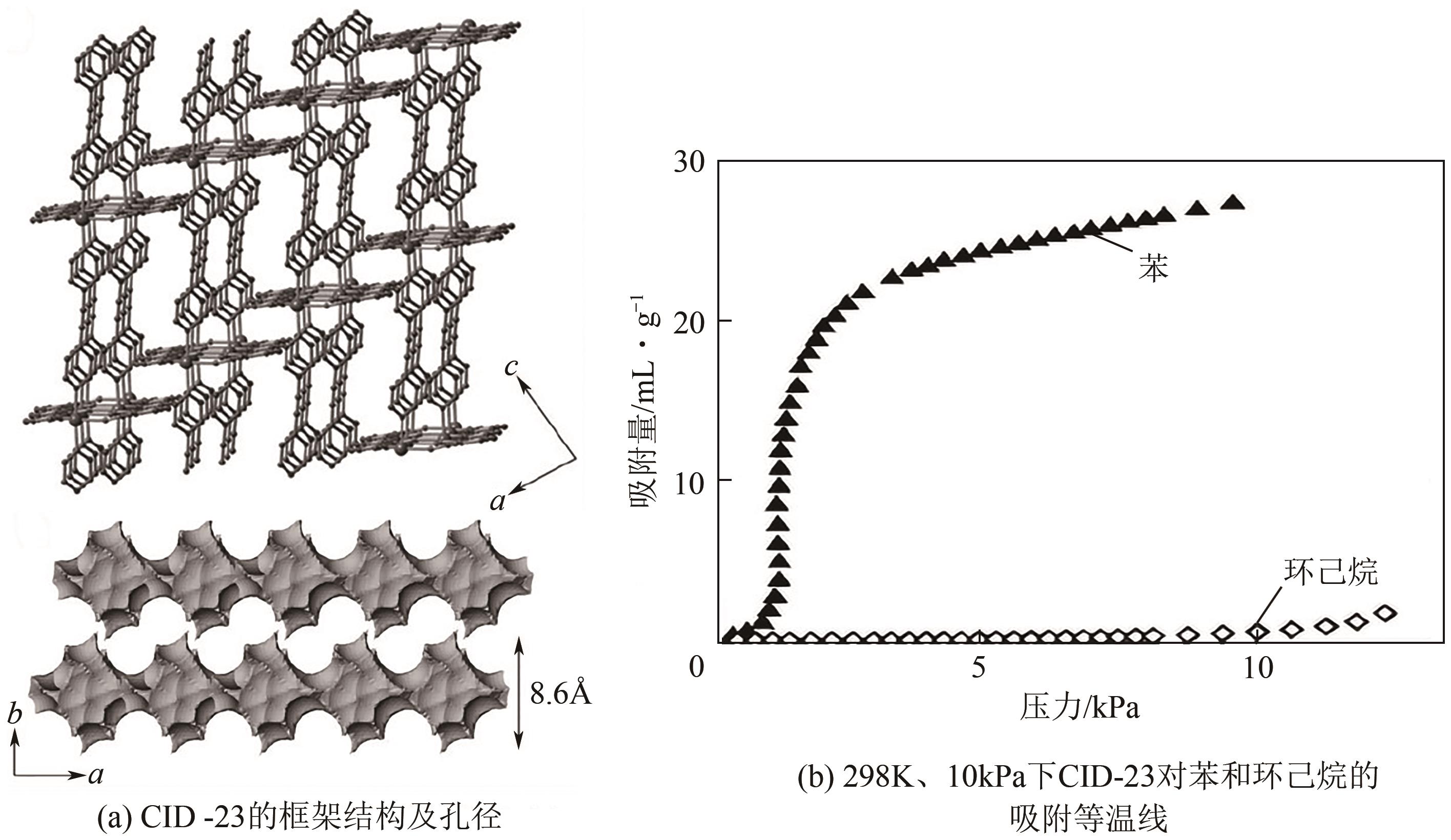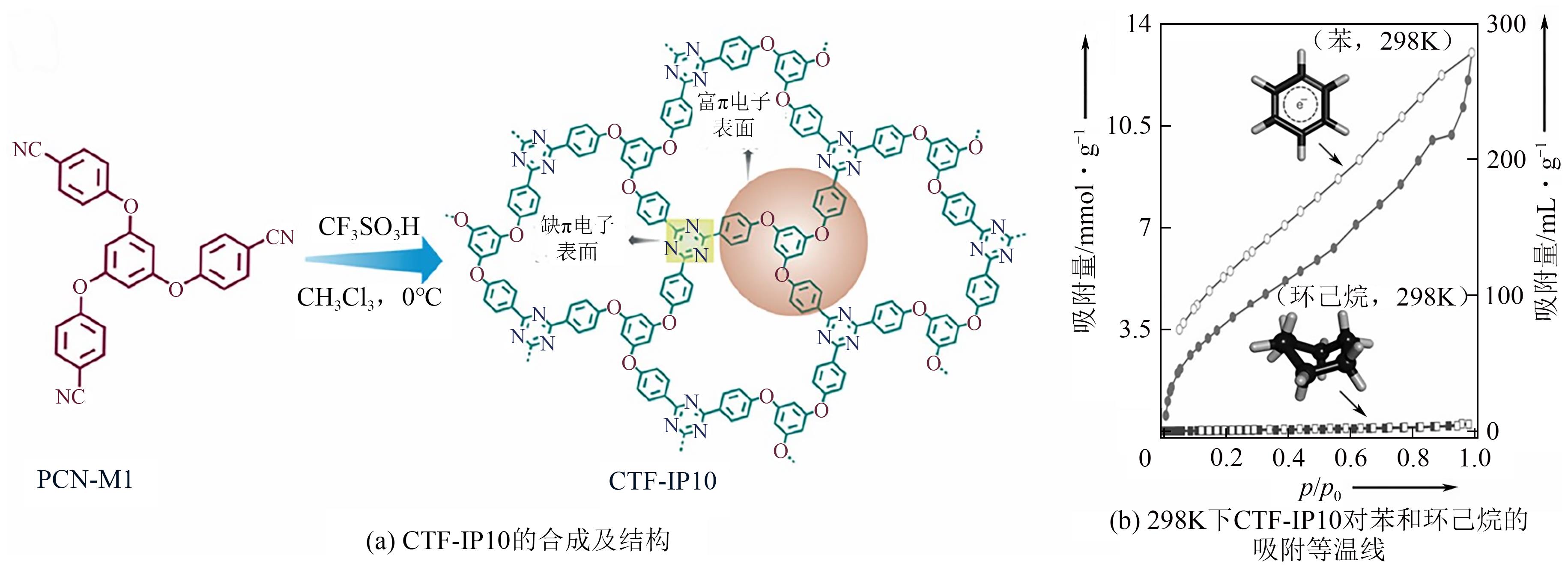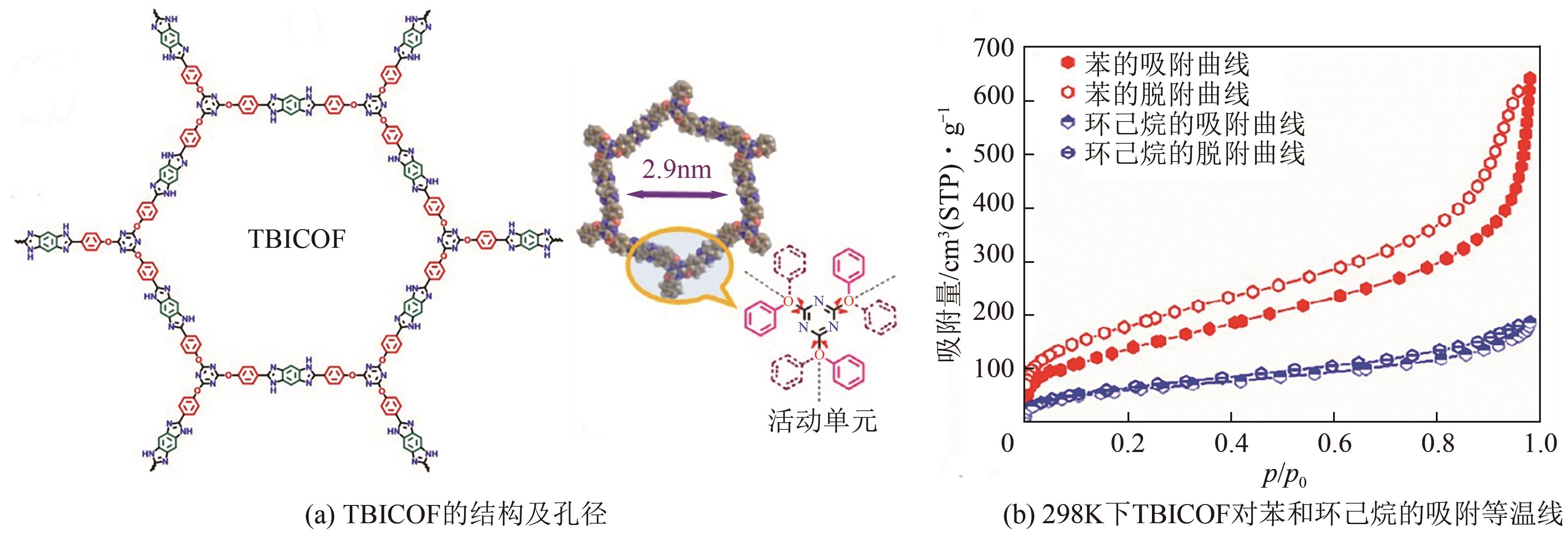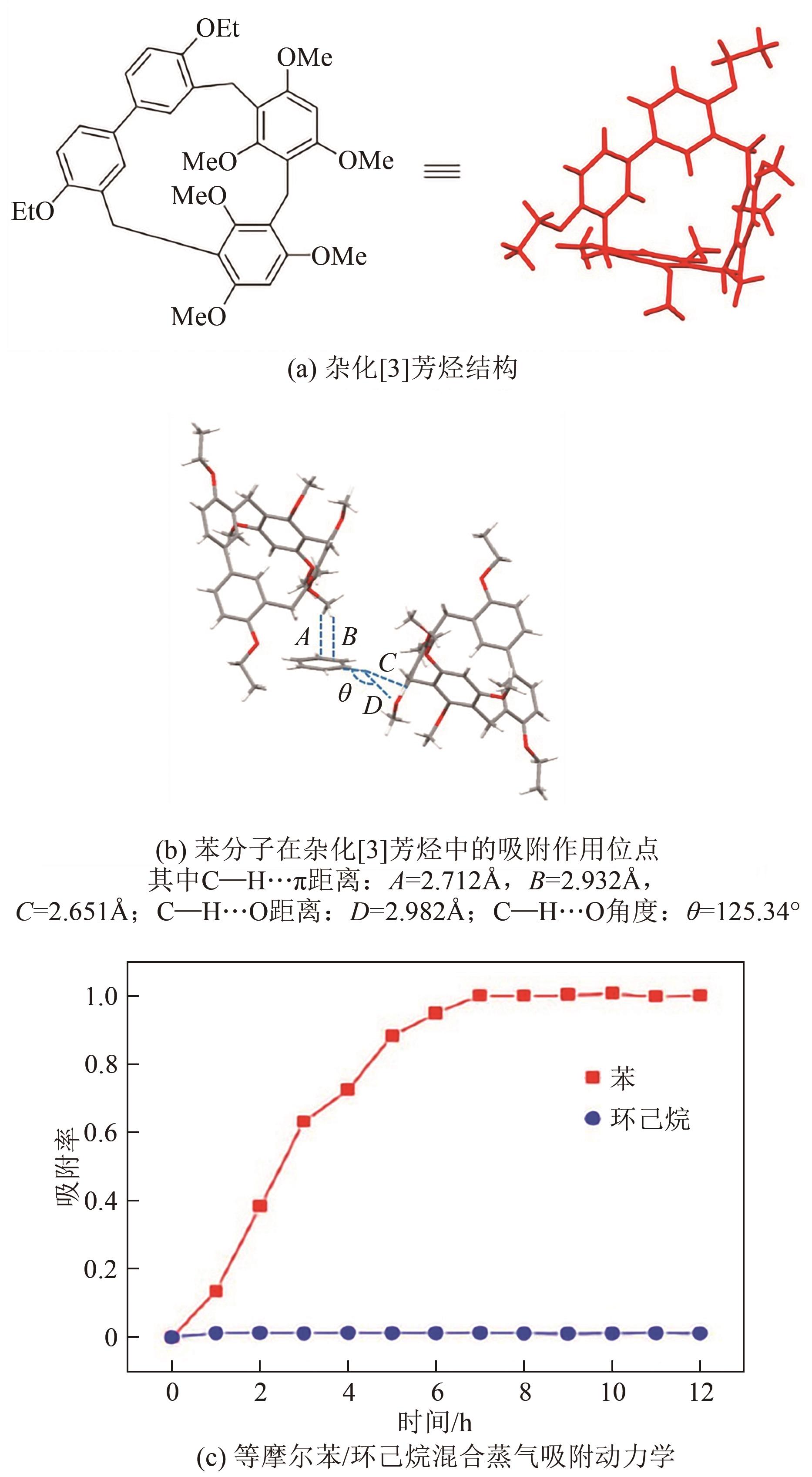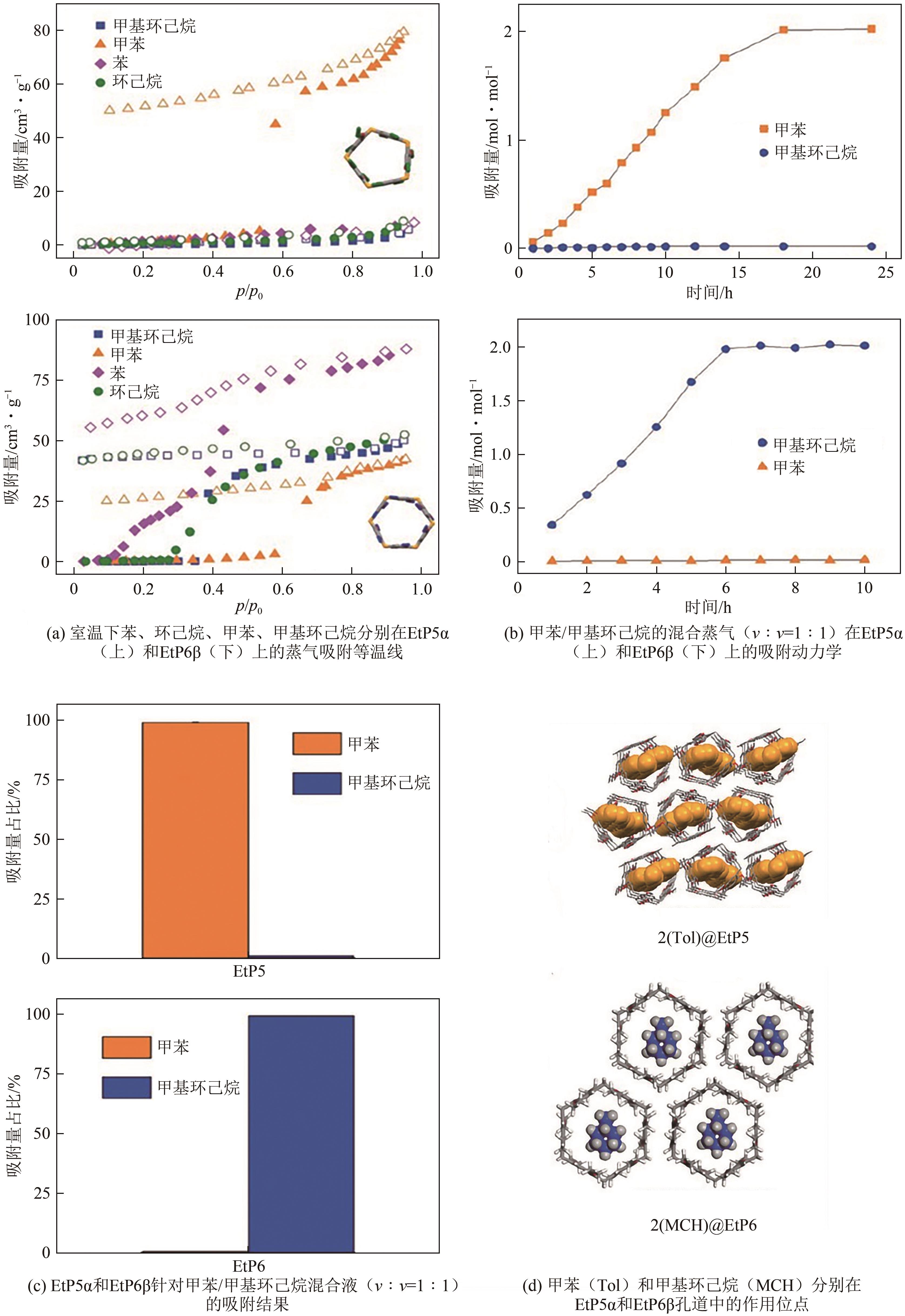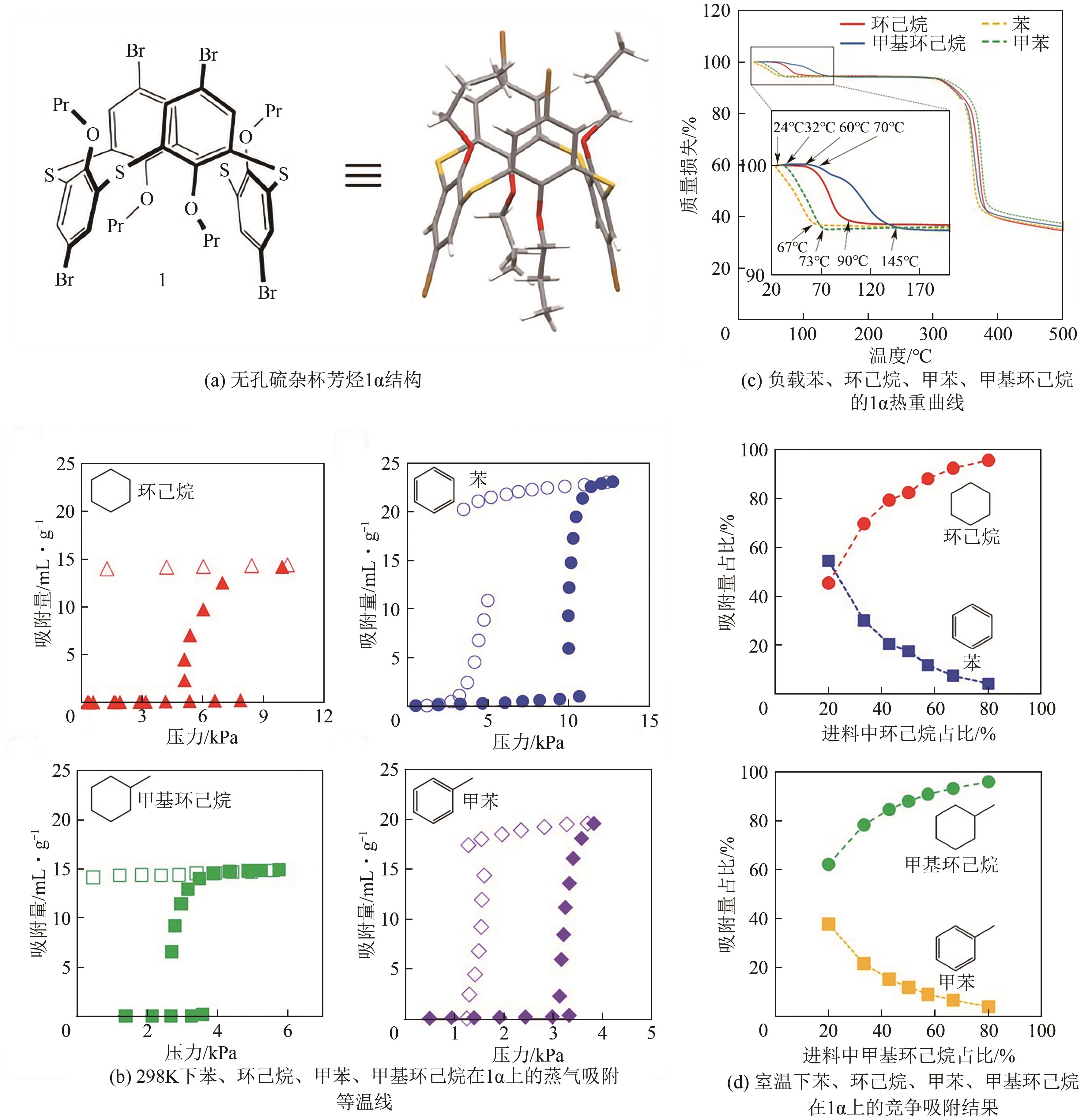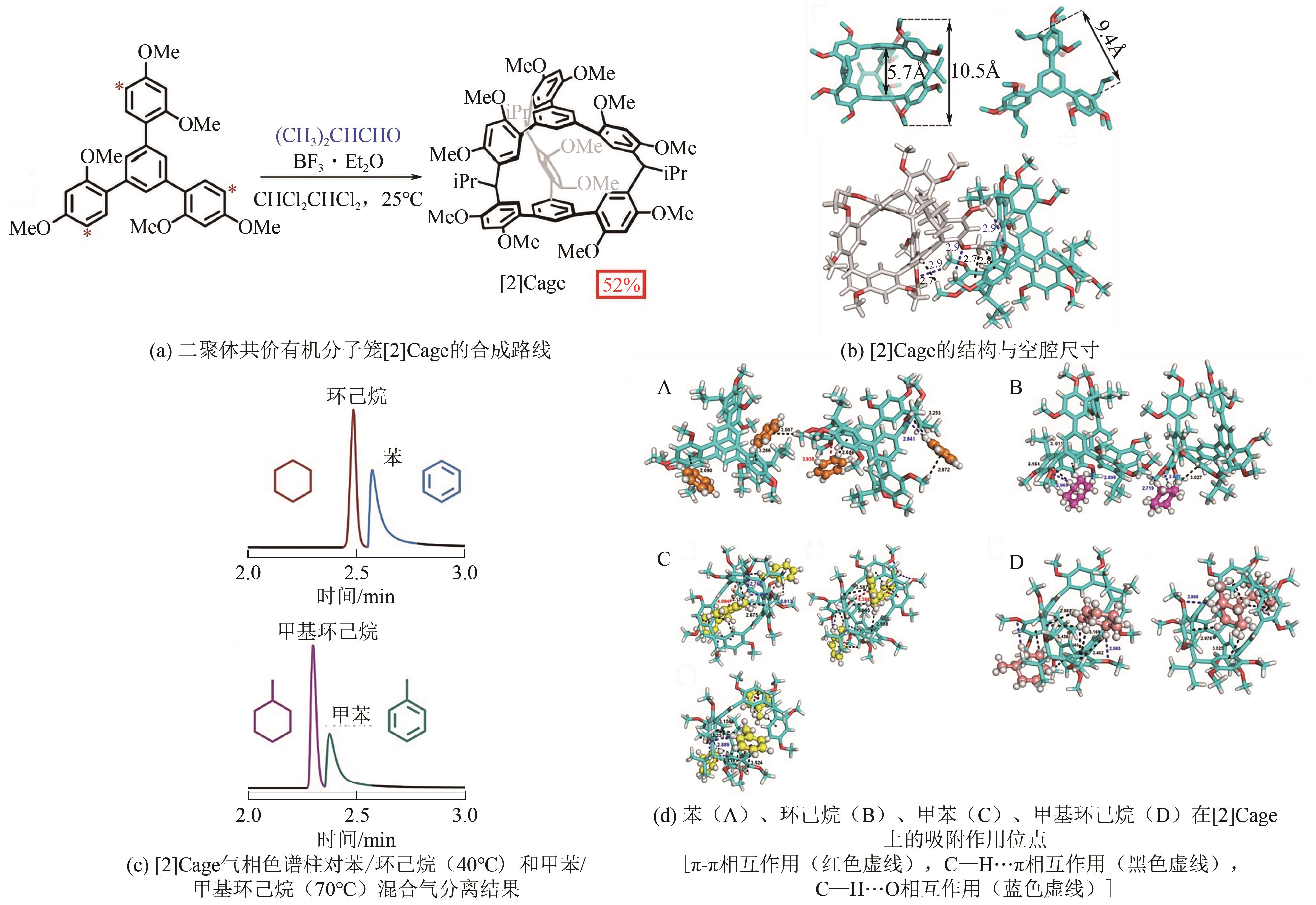Chemical Industry and Engineering Progress ›› 2024, Vol. 43 ›› Issue (4): 1863-1881.DOI: 10.16085/j.issn.1000-6613.2023-0533
• Materials science and technology • Previous Articles
Advances in adsorbents for aromatics/cycloalkanes separation
JIN Binhao1( ), ZHU Xiaoqian1, KE Tian1, ZHANG Zhiguo1,2, BAO Zongbi1,2, REN Qilong1,2, SU Baogen1, YANG Qiwei1,2(
), ZHU Xiaoqian1, KE Tian1, ZHANG Zhiguo1,2, BAO Zongbi1,2, REN Qilong1,2, SU Baogen1, YANG Qiwei1,2( )
)
- 1.College of Chemical and Biological Engineering, Key Laboratory of Biomass Chemical Engineering, Zhejiang University, Hangzhou 310058, Zhejiang, China
2.Institute of Zhejiang University-Quzhou, Quzhou 324000, Zhejiang, China
-
Received:2023-04-06Revised:2023-06-05Online:2024-05-13Published:2024-04-15 -
Contact:YANG Qiwei
芳香烃/环烷烃吸附分离材料研究进展
金彬浩1( ), 朱小倩1, 柯天1, 张治国1,2, 鲍宗必1,2, 任其龙1,2, 苏宝根1, 杨启炜1,2(
), 朱小倩1, 柯天1, 张治国1,2, 鲍宗必1,2, 任其龙1,2, 苏宝根1, 杨启炜1,2( )
)
- 1.浙江大学化学工程与生物工程学院,生物质化工教育部重点实验室,浙江 杭州 310058
2.浙江大学衢州 研究院,浙江 衢州 324000
-
通讯作者:杨启炜 -
作者简介:金彬浩(1997—),男,硕士研究生,研究方向为分子辨识分离工程。E-mail:jinbinhao@zju.edu.cn。 -
基金资助:国家自然科学基金(22178305);浙江省自然科学基金(LR21B060002)
CLC Number:
Cite this article
JIN Binhao, ZHU Xiaoqian, KE Tian, ZHANG Zhiguo, BAO Zongbi, REN Qilong, SU Baogen, YANG Qiwei. Advances in adsorbents for aromatics/cycloalkanes separation[J]. Chemical Industry and Engineering Progress, 2024, 43(4): 1863-1881.
金彬浩, 朱小倩, 柯天, 张治国, 鲍宗必, 任其龙, 苏宝根, 杨启炜. 芳香烃/环烷烃吸附分离材料研究进展[J]. 化工进展, 2024, 43(4): 1863-1881.
share this article
Add to citation manager EndNote|Ris|BibTeX
URL: https://hgjz.cip.com.cn/EN/10.16085/j.issn.1000-6613.2023-0533
| 名称 | 分子结构 | 分子尺寸/Å | 动力学直径/Å | 沸点/K | 极化率/10-24cm3 | ||
|---|---|---|---|---|---|---|---|
| X | Y | Z | |||||
| 苯 | 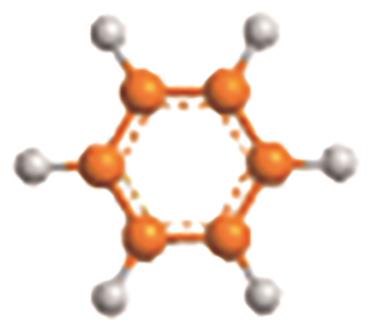 | 7.3 | 6.6 | 3.3 | 5.35~5.85 | 353.3 | 10.0~10.7 |
| 环己烷 | 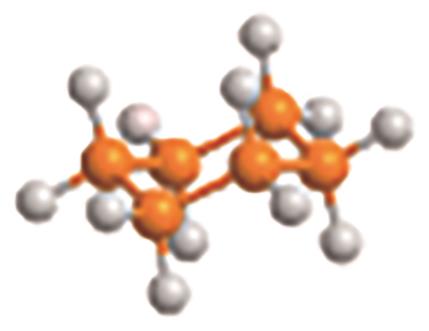 | 7.2 | 6.6 | 5.0 | 6.0 | 353.9 | 10.8~11.7 |
| 甲苯 | 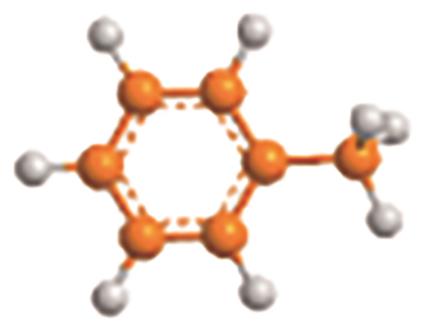 | 8.3 | 6.6 | 4.0 | 5.25 | 383 | 12.32 |
| 甲基环己烷 | 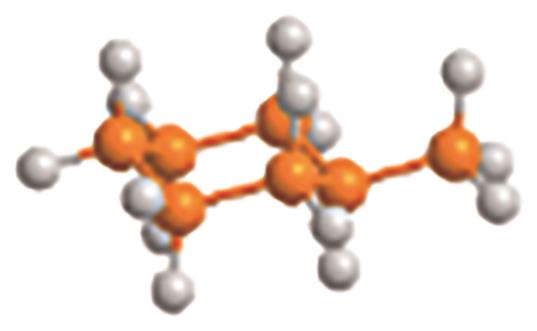 | 8.3 | 6.6 | 5.1 | 6.49 | 374 | 12.83 |
| 名称 | 分子结构 | 分子尺寸/Å | 动力学直径/Å | 沸点/K | 极化率/10-24cm3 | ||
|---|---|---|---|---|---|---|---|
| X | Y | Z | |||||
| 苯 |  | 7.3 | 6.6 | 3.3 | 5.35~5.85 | 353.3 | 10.0~10.7 |
| 环己烷 |  | 7.2 | 6.6 | 5.0 | 6.0 | 353.9 | 10.8~11.7 |
| 甲苯 |  | 8.3 | 6.6 | 4.0 | 5.25 | 383 | 12.32 |
| 甲基环己烷 |  | 8.3 | 6.6 | 5.1 | 6.49 | 374 | 12.83 |
| 吸附剂 | 优先吸附芳香烃 | ||||||||
|---|---|---|---|---|---|---|---|---|---|
| 温度/K | 静态吸附容量/mmol·g-1 | 静态吸附组分压力/kPa | 吸附分离机理 | ||||||
| Cu2I2(BTTP4)[ | — | Bz(2.60), Cy(1.43) | p0① | 热力学 | |||||
| Ni3(OH)(Ina)3(BDC)1.5[ | 298 | Bz(3.83), Cy(0.17) | p0① | 热力学 | |||||
| ZnL[ | 298 | Bz(1.47), Cy(0.45) | p0① | 热力学 | |||||
| DAT-MOF-1[ | 298 | Bz(1.50), Cy(0.20) | 100 | 热力学 | |||||
| Mn-MOF-74[ | 298 | Bz(9.38), Cy(0.25) | 12.5 | 热力学 | |||||
| MAF-24β[ | 298 | Bz(2.57), Cy(0.20) | p0① | 刚性排阻 | |||||
| MAF-stu-13[ | 298 | Bz(2.59), Cy(0.21) | p0① | 刚性排阻 | |||||
| Li2Zn2(NO2-bdc)3(bpy)[ | 293 | Bz(2.90), Cy(0.18) | p0① | 刚性排阻 | |||||
| Zn(μ4-TCNQ-TCNQ)bpy[ | 298 | Bz(3.57), Cy(0.89) | p0① | 柔性排阻 | |||||
| CID-23[ | 298 | Bz(1.20), Cy(0.09) | 10 | 柔性排阻 | |||||
| Cu(bpp)2(BF4)2[ | 283 | Bz(3.18), Cy(trace)② | p0① | 柔性排阻 | |||||
| CTF-IP10[ | 298 | Bz(12.43), Cy(trace)② | p0① | 热力学 | |||||
| TBICOF[ | 298 | Bz(28.66), Cy(8.31) | p0① | 热力学 | |||||
| CMP-S-1[ | 298 | Bz(8.30), Cy(4.50) | p0① | 热力学 | |||||
| 杂化[ | 298 | Bz(1.30), Cy(trace)② | p0① | 热力学 | |||||
| TAPM-1[ | 298 | Bz(3.71), Cy(0.17), TOL(2.28), MCH(0.31) | 12 | 热力学 | |||||
| [ | — | — | — | 热力学 | |||||
| EtP5α[ | 298 | TOL:MCH = 98.8:1.2(liquid)④ | P0① | 柔性排阻 | |||||
| 吸附剂 | 优先吸附环烷烃 | ||||||||
| 温度/K | 模拟穿透时间/min·g-1 | 模拟穿透条件 (分压,载气流速) | 等摩尔混合气(液)吸附比 | 吸附分离机理 | |||||
| MUF-77[ | 293 | 苯(100),环己烷(180) | 0.5kPa, 100mLN/min | — | 热力学 | ||||
| CUB-30[ | 293 | 苯(30),环己烷(400) | 0.5kPa, 100mLN/min | — | 热力学 | ||||
[Zn12(tdc)6(glycolate)6(dabco)3] (glycolate = 1,2-戊二醇)[ | — | — | — | Bz∶Cy = 0.2∶1(气) Bz∶Cy = 0.4∶1(液) | 热力学 | ||||
| EtP6β[ | 298 | TOL∶MCH = 0.8∶99.2(液) | 柔性排阻 | ||||||
| 1α[ | 298 | — | — | Bz∶Cy = 0.17∶0.83(气) TOL∶MCH = 0.14∶0.86(气) | 热力学 | ||||
| 吸附剂 | 优先吸附芳香烃 | ||||||||
|---|---|---|---|---|---|---|---|---|---|
| 温度/K | 静态吸附容量/mmol·g-1 | 静态吸附组分压力/kPa | 吸附分离机理 | ||||||
| Cu2I2(BTTP4)[ | — | Bz(2.60), Cy(1.43) | p0① | 热力学 | |||||
| Ni3(OH)(Ina)3(BDC)1.5[ | 298 | Bz(3.83), Cy(0.17) | p0① | 热力学 | |||||
| ZnL[ | 298 | Bz(1.47), Cy(0.45) | p0① | 热力学 | |||||
| DAT-MOF-1[ | 298 | Bz(1.50), Cy(0.20) | 100 | 热力学 | |||||
| Mn-MOF-74[ | 298 | Bz(9.38), Cy(0.25) | 12.5 | 热力学 | |||||
| MAF-24β[ | 298 | Bz(2.57), Cy(0.20) | p0① | 刚性排阻 | |||||
| MAF-stu-13[ | 298 | Bz(2.59), Cy(0.21) | p0① | 刚性排阻 | |||||
| Li2Zn2(NO2-bdc)3(bpy)[ | 293 | Bz(2.90), Cy(0.18) | p0① | 刚性排阻 | |||||
| Zn(μ4-TCNQ-TCNQ)bpy[ | 298 | Bz(3.57), Cy(0.89) | p0① | 柔性排阻 | |||||
| CID-23[ | 298 | Bz(1.20), Cy(0.09) | 10 | 柔性排阻 | |||||
| Cu(bpp)2(BF4)2[ | 283 | Bz(3.18), Cy(trace)② | p0① | 柔性排阻 | |||||
| CTF-IP10[ | 298 | Bz(12.43), Cy(trace)② | p0① | 热力学 | |||||
| TBICOF[ | 298 | Bz(28.66), Cy(8.31) | p0① | 热力学 | |||||
| CMP-S-1[ | 298 | Bz(8.30), Cy(4.50) | p0① | 热力学 | |||||
| 杂化[ | 298 | Bz(1.30), Cy(trace)② | p0① | 热力学 | |||||
| TAPM-1[ | 298 | Bz(3.71), Cy(0.17), TOL(2.28), MCH(0.31) | 12 | 热力学 | |||||
| [ | — | — | — | 热力学 | |||||
| EtP5α[ | 298 | TOL:MCH = 98.8:1.2(liquid)④ | P0① | 柔性排阻 | |||||
| 吸附剂 | 优先吸附环烷烃 | ||||||||
| 温度/K | 模拟穿透时间/min·g-1 | 模拟穿透条件 (分压,载气流速) | 等摩尔混合气(液)吸附比 | 吸附分离机理 | |||||
| MUF-77[ | 293 | 苯(100),环己烷(180) | 0.5kPa, 100mLN/min | — | 热力学 | ||||
| CUB-30[ | 293 | 苯(30),环己烷(400) | 0.5kPa, 100mLN/min | — | 热力学 | ||||
[Zn12(tdc)6(glycolate)6(dabco)3] (glycolate = 1,2-戊二醇)[ | — | — | — | Bz∶Cy = 0.2∶1(气) Bz∶Cy = 0.4∶1(液) | 热力学 | ||||
| EtP6β[ | 298 | TOL∶MCH = 0.8∶99.2(液) | 柔性排阻 | ||||||
| 1α[ | 298 | — | — | Bz∶Cy = 0.17∶0.83(气) TOL∶MCH = 0.14∶0.86(气) | 热力学 | ||||
| 1 | ZHOU Jingyi, KE Tian, STEINKE Felix, et al. Tunable confined aliphatic pore environment in robust metal-organic frameworks for efficient separation of gases with a similar structure[J]. Journal of the American Chemical Society, 2022, 144(31): 14322-14329. |
| 2 | SHEN Jin, HE Xin, KE Tian, et al. Simultaneous interlayer and intralayer space control in two-dimensional metal-organic frameworks for acetylene/ethylene separation[J]. Nature Communications, 2020, 11(1): 6259. |
| 3 | KE Tian, WANG Qingju, SHEN Jin, et al. Molecular sieving of C2-C3 alkene from alkyne with tuned threshold pressure in robust layered metal-organic frameworks[J]. Angewandte Chemie International Edition, 2020, 59(31): 12725-12730. |
| 4 | WANG Zhaohua, DONG Chunyang, TANG Xuan, et al. CO-tolerant RuNi/TiO2 catalyst for the storage and purification of crude hydrogen[J]. Nature Communications, 2022, 13: 4404. |
| 5 | OKADA Yoshimi, SASAKI Eiji, WATANABE Eiji, et al. Development of dehydrogenation catalyst for hydrogen generation in organic chemical hydride method[J]. International Journal of Hydrogen Energy, 2006, 31(10): 1348-1356. |
| 6 | WU Dan, BAAZIZ Walid, GU Bang, et al. Surface molecular imprinting over supported metal catalysts for size-dependent selective hydrogenation reactions[J]. Nature Catalysis, 2021, 4(7): 595-606. |
| 7 | HADJ-KALI Mohamed K, SALLEH M Zulhaziman M, WAZEER Irfan, et al. Separation of benzene and cyclohexane using eutectic solvents with aromatic structure[J]. Molecules, 2022, 27(13): 4041. |
| 8 | SALLEH M, HADJ-KALI M, WAZEER I, et al. Extractive separation of benzene and cyclohexane using binary mixtures of ionic liquids[J]. Journal of Molecular Liquids, 2019, 285: 716-726. |
| 9 | SALLEH Zulhaziman, WAZEER Irfan, MULYONO Sarwono, et al. Efficient removal of benzene from cyclohexane-benzene mixtures using deep eutectic solvents-COSMO-RS screening and experimental validation[J]. The Journal of Chemical Thermodynamics, 2017, 104: 33-44. |
| 10 | LI Wenxue, XU Bo, LEI Zhigang, et al. Separation of benzene and cyclohexane by extractive distillation intensified with ionic liquid[J]. Chemical Engineering and Processing - Process Intensification, 2018, 126: 81-89. |
| 11 | AYUSO Miguel, Andrés CAÑADA-BARCALA, LARRIBA Marcos, et al. Enhanced separation of benzene and cyclohexane by homogeneous extractive distillation using ionic liquids as entrainers[J]. Separation and Purification Technology, 2020, 240: 116583. |
| 12 | BROUWER Thomas, SCHUUR Boelo. Bio-based solvents as entrainers for extractive distillation in aromatic/aliphatic and olefin/paraffin separation[J]. Green Chemistry, 2020, 22(16): 5369-5375. |
| 13 | GARCIA VILLALUENGA J P, TABE-MOHAMMADI A. A review on the separation of benzene/cyclohexane mixtures by pervaporation processes[J]. Journal of Membrane Science, 2000, 169(2): 159-174. |
| 14 | BELL Carl-Martin, HUANG Ivy, ZHOU Meijuan, et al. A vapor permeation processes for the separation of aromatic compounds from aliphatic compounds[J]. Separation Science and Technology, 2014, 49(15): 2271-2279. |
| 15 | ANWAR Fahmi, KHALEEL Maryam, WANG Kean, et al. Selectivity tuning of adsorbents for ethane/ethylene separation: A review[J]. Industrial & Engineering Chemistry Research, 2022, 61(34): 12269-12293. |
| 16 | ZHANG Ling, LI Libo, HU Enlai, et al. Boosting ethylene/ethane separation within copper(I)-chelated metal-organic frameworks through tailor-made aperture and specific π-complexation[J]. Advanced Science, 2020, 7(2): 1901918. |
| 17 | XIANG Huan, SHAO Yan, AMEEN Ahmed, et al. Adsorptive separation of C2H6/C2H4 on metal-organic frameworks (MOFs) with pillared-layer structures[J]. Separation and Purification Technology, 2020, 242: 116819. |
| 18 | DING Qi, ZHANG Zhaoqiang, YU Cong, et al. Exploiting equilibrium-kinetic synergetic effect for separation of ethylene and ethane in a microporous metal-organic framework[J]. Science Advances, 2020, 6(15): eaaz4322. |
| 19 | LI Libo, LIN Ruibiao, WANG Xiaoqing, et al. Kinetic separation of propylene over propane in a microporous metal-organic framework[J]. Chemical Engineering Journal, 2018, 354: 977-982. |
| 20 | XIE Yi, SHI Yanshu, CUI Hui, et al. Efficient separation of propylene from propane in an ultramicroporous cyanide-based compound with open metal sites[J]. Small Structures, 2022, 3(5): 2100125. |
| 21 | CADIAU A, ADIL K, BHATT P M, et al. A metal-organic framework-based splitter for separating propylene from propane[J]. Science, 2016, 353(6295): 137-140. |
| 22 | TIAN Xiaoyun, ZHOU Haolong, ZHANG Xuewen, et al. Two isostructural flexible porous coordination polymers showing contrasting single-component and mixture adsorption properties for propylene/propane[J]. Inorganic Chemistry, 2020, 59(9): 6047-6052. |
| 23 | DING Qi, ZHANG Sui. Recent advances in the development of metal-organic frameworks for propylene and propane separation[J]. Energy & Fuels, 2022, 36(14): 7337-7361. |
| 24 | LIU Shanshan, HAN Xue, CHAI Yuchao, et al. Efficient separation of acetylene and carbon dioxide in a decorated zeolite[J]. Angewandte Chemie International Edition, 2021, 60(12): 6526-6532. |
| 25 | LI Peng, HE Yabing, ZHAO Yunfeng, et al. A rod-packing microporous hydrogen-bonded organic framework for highly selective separation of C2H2/CO2 at room temperature[J]. Angewandte Chemie International Edition, 2015, 54(2): 574-577. |
| 26 | WANG Jun, ZHANG Yan, SU Yun, et al. Fine pore engineering in a series of isoreticular metal-organic frameworks for efficient C2H2/CO2 separation[J]. Nature Communications, 2022, 13(1): 200. |
| 27 | HERM Zoey R, WIERS Brian M, MASON Jarad A, et al. Separation of hexane isomers in a metal-organic framework with triangular channels[J]. Science, 2013, 340(6135): 960-964. |
| 28 | YU Liang, DONG Xinglong, GONG Qihan, et al. Splitting mono- and dibranched alkane isomers by a robust aluminum-based metal-organic framework material with optimal pore dimensions[J]. Journal of the American Chemical Society, 2020, 142(15): 6925-6929. |
| 29 | MENDES Patricia A P, HORCAJADA Patricia, RIVES Sébastien, et al. A complete separation of hexane isomers by a functionalized flexible metal organic framework[J]. Advanced Functional Materials, 2014, 24(48): 7666-7673. |
| 30 | WANG Hao, DONG Xinglong, VELASCO Ever, et al. One-of-a-kind: A microporous metal-organic framework capable of adsorptive separation of linear, mono- and di-branched alkane isomers via temperature- and adsorbate-dependent molecular sieving[J]. Energy & Environmental Science, 2018, 11(5): 1226-1231. |
| 31 | LI Xiaolin, WANG Juehua, BAI Nannan, et al. Refinement of pore size at sub-angstrom precision in robust metal-organic frameworks for separation of xylenes[J]. Nature Communications, 2020, 11: 4280. |
| 32 | LI Liangying, GUO Lidong, OLSON David H, et al. Discrimination of xylene isomers in a stacked coordination polymer[J]. Science, 2022, 377(6603): 335-339. |
| 33 | GONZALEZ Miguel I, KAPELEWSKI Matthew T, BLOCH Eric D, et al. Separation of xylene isomers through multiple metal site interactions in metal-organic frameworks[J]. Journal of the American Chemical Society, 2018, 140(9): 3412-3422. |
| 34 | YANG Liping, LIU Hanbang, XING Jiacheng, et al. Separation of xylene isomers in the anion-pillared square grid material SIFSIX-1-Cu[J]. Chemistry-A European Journal, 2021, 27(20): 6187-6190. |
| 35 | ZHOU Jingyi, KE Tian, SONG Yifei, et al. Highly efficient separation of C8 aromatic isomers by rationally designed nonaromatic metal-organic frameworks[J]. Journal of the American Chemical Society, 2022, 144(46): 21417-21424. |
| 36 | GONZÁLEZ-GALÁN C, LUNA-TRIGUERO A, VICENT-LUNA J M, et al. Exploiting the π-bonding for the separation of benzene and cyclohexane in zeolites[J]. Chemical Engineering Journal, 2020, 398: 125678. |
| 37 | WANG Hao, LIU Yunling, LI Jing. Designer metal-organic frameworks for size-exclusion-based hydrocarbon separations: Progress and challenges[J]. Advanced Materials, 2020, 32(44): e2002603. |
| 38 | CHEN Cheng, GUAN Haiyan, LI Hengbo, et al. A noncovalent π-stacked porous organic molecular framework for selective separation of aromatics and cyclic aliphatics[J]. Angewandte Chemie International Edition, 2022, 61(24): e202201646. |
| 39 | ZHOU Hongcai, LONG Jeffrey R, YAGHI Omar M. Introduction to metal-organic frameworks[J]. Chemical Reviews, 2012, 112(2): 673-674. |
| 40 | POLYUKHOV Daniil M, PORYVAEV Artem S, SUKHIKH Aleksandr S, et al. Fine-tuning window apertures in ZIF-8/67 frameworks by metal ions and temperature for high-efficiency molecular sieving of xylenes[J]. ACS Applied Materials & Interfaces, 2021, 13(34): 40830-40836. |
| 41 | YUAN Shuai, HUANG Lan, HUANG Zhehao, et al. Continuous variation of lattice dimensions and pore sizes in metal-organic frameworks[J]. Journal of the American Chemical Society, 2020, 142(10): 4732-4738. |
| 42 | WANG Xun, NIU Zheng, AL-ENIZI Abdullah M, et al. Pore environment engineering in metal-organic frameworks for efficient ethane/ethylene separation[J]. Journal of Materials Chemistry A, 2019, 7(22): 13585-13590. |
| 43 | WANG Gangding, KRISHNA Rajamani, LI Yongzhi, et al. Boosting ethane/ethylene separation by MOFs through the amino-functionalization of pores[J]. Angewandte Chemie International Edition, 2022, 61(48): e202213015. |
| 44 | AGRAWAL Mayank, BHATTACHARYYA Souryadeep, HUANG Yi, et al. Liquid-phase multicomponent adsorption and separation of xylene mixtures by flexible MIL-53 adsorbents[J]. The Journal of Physical Chemistry C, 2018, 122(1): 386-397. |
| 45 | PANG Jiandong, DI Zhengyi, QIN Junsheng, et al. Precisely embedding active sites into a mesoporous Zr-framework through linker installation for high-efficiency photocatalysis[J]. Journal of the American Chemical Society, 2020, 142(35): 15020-15026. |
| 46 | XIAO Yingbo, GONG Wei, GUO Sijia, et al. Regulating coordination environment in metal-organic frameworks for adsorption and redox conversion of polysulfides in lithium-sulfur batteries[J]. ACS Materials Letters, 2021, 3(12): 1684-1694. |
| 47 | ZHENG Fang, CHEN Rundao, ZHANG Zhiguo, et al. Cooperative control of intralayer and interlayer space in MOFs enables selective capture of intermediate-sized molecules[J]. Cell Reports Physical Science, 2022, 3(6): 100903. |
| 48 | CHEN Fuqiang, LAI Dan, GUO Lidong, et al. Deep desulfurization with record SO2 adsorption on the metal-organic frameworks[J]. Journal of the American Chemical Society, 2021, 143(24): 9040-9047. |
| 49 | WU Kaiyi, GUO Lidong, ZHANG Zhiguo, et al. Shaping of gallate-based metal-organic frameworks for adsorption separation of ethylene from acetylene and ethane[J]. Journal of Colloid and Interface Science, 2021, 581: 177-184. |
| 50 | ZHANG Yaru, XIE Xiaozheng, YIN Xuebo, et al. Flexible ligand for metal-organic frameworks with simultaneous large-pore and antenna effect emission[J]. Chemical Engineering Journal, 2022, 443: 136532. |
| 51 | LUO Feng, YAN Changsheng, DANG Lilong, et al. UTSA-74: A MOF-74 isomer with two accessible binding sites per metal center for highly selective gas separation[J]. Journal of the American Chemical Society, 2016, 138(17): 5678-5684. |
| 52 | ZHOU Dongdong, ZHANG Jiepeng. On the role of flexibility for adsorptive separation[J]. Accounts of Chemical Research, 2022, 55(20): 2966-2977. |
| 53 | MONNI Noemi, Eduardo ANDRES-GARCIA, Katia CAAMAÑO, et al. A thermally/chemically robust and easily regenerable anilato-based ultramicroporous 3D MOF for CO2 uptake and separation[J]. Journal of Materials Chemistry A, 2021, 9(44): 25189-25195. |
| 54 | YANG Rui, LI Lei, XIONG Ying, et al. Two robust porous metal-organic frameworks sustained by distinct catenation: Selective gas sorption and single-crystal-to-single-crystal guest exchange[J]. Chemistry: An Asian Journal, 2010, 5(11): 2358-2368. |
| 55 | REN Guojian, LIU Shuxia, MA Fengji, et al. A 9-connected metal-organic framework with gas adsorption properties[J]. Journal of Materials Chemistry, 2011, 21(40): 15909-15913. |
| 56 | JOARDER Biplab, MUKHERJEE Soumya, CHAUDHARI Abhijeet K, et al. Guest-responsive function of a dynamic metal-organic framework with a π Lewis acidic pore surface[J]. Chemistry: A European Journal, 2014, 20(47): 15303-15308. |
| 57 | MANNA Biplab, MUKHERJEE Soumya, DESAI Aamod V, et al. A π-electron deficient diaminotriazine functionalized MOF for selective sorption of benzene over cyclohexane[J]. Chemical Communications, 2015, 51(84): 15386-15389. |
| 58 | Manuel DÍAZ-GARCÍA, Álvaro MAYORAL, Isabel DÍAZ, et al. Nanoscaled M-MOF-74 materials prepared at room temperature[J]. Crystal Growth & Design, 2014, 14(5): 2479-2487. |
| 59 | DE OLIVEIRA Aline, DE LIMA Guilherme Ferreira, DE ABREU Heitor Avelino. Structural and electronic properties of M-MOF-74 (M = Mg, Co or Mn)[J]. Chemical Physics Letters, 2018, 691: 283-290. |
| 60 | Gabriel FLORES J, Manuel DÍAZ-GARCÍA, IBARRA Ilich A, et al. Sustainable M-MOF-74 (M = Cu, Co, Zn) prepared in methanol as heterogeneous catalysts in the synthesis of benzaldehyde from styrene oxidation[J]. Journal of Solid State Chemistry, 2021, 298: 122151. |
| 61 | MUKHERJEE Soumya, MANNA Biplab, DESAI Aamod V, et al. Harnessing Lewis acidic open metal sites of metal-organic frameworks: The foremost route to achieve highly selective benzene sorption over cyclohexane[J]. Chemical Communications, 2016, 52(53): 8215-8218. |
| 62 | MACREADIE Lauren K, BABARAO Ravichandar, SETTER Caitlin J, et al. Enhancing multicomponent metal-organic frameworks for low pressure liquid organic hydrogen carrier separations[J]. Angewandte Chemie International Edition, 2020, 59(15): 6090-6098. |
| 63 | LIU Lujia, TELFER Shane G. Systematic ligand modulation enhances the moisture stability and gas sorption characteristics of quaternary metal-organic frameworks[J]. Journal of the American Chemical Society, 2015, 137(11): 3901-3909. |
| 64 | LYSOVA Anna A, SAMSONENKO Denis G, DOROVATOVSKII Pavel V, et al. Tuning the molecular and cationic affinity in a series of multifunctional metal-organic frameworks based on dodecanuclear Zn(Ⅱ) carboxylate wheels[J]. Journal of the American Chemical Society, 2019, 141(43): 17260-17269. |
| 65 | LIN Jianbin, ZHANG Jiepeng, ZHANG Weixiong, et al. Porous manganese(Ⅱ) 3-(2-pyridyl)-5-(4-pyridyl)-1,2,4-triazolate frameworks: Rational self-assembly, supramolecular isomerism, solid-state transformation, and sorption properties[J]. Inorganic Chemistry, 2009, 48(14): 6652-6660. |
| 66 | YE Chunrong, WANG Wenjian, CHEN Wei, et al. Harnessing shape complementarity for upgraded cyclohexane purification through adaptive bottlenecked pores in an imidazole-containing MOF[J]. Angewandte Chemie International Edition, 2021, 60(44): 23590-23595. |
| 67 | SAPIANIK Aleksandr A, KOVALENKO Konstantin A, SAMSONENKO Denis G, et al. Exceptionally effective benzene/cyclohexane separation using a nitro-decorated metal-organic framework[J]. Chemical Communications, 2020, 56(59): 8241-8244. |
| 68 | SHIMOMURA Satoru, HORIKE Satoshi, MATSUDA Ryotaro, et al. Guest-specific function of a flexible undulating channel in a 7,7,8,8-tetracyano-p-quinodimethane dimer-based porous coordination polymer[J]. Journal of the American Chemical Society, 2007, 129(36): 10990-10991. |
| 69 | HIJIKATA Yuh, HORIKE Satoshi, SUGIMOTO Masayuki, et al. Relationship between channel and sorption properties in coordination polymers with interdigitated structures[J]. Chemistry: A European Journal, 2011, 17(18): 5138-5144. |
| 70 | KONDO Atsushi, SUZUKI Takayuki, KOTANI Ryosuke, et al. Liquid/vapor-induced reversible dynamic structural transformation of a three-dimensional Cu-based MOF to a one-dimensional MOF showing gate adsorption[J]. Dalton Transactions, 2017, 46(20): 6762-6768. |
| 71 | KANDAMBETH Sharath, Kaushik DEY, BANERJEE Rahul. Covalent organic frameworks: Chemistry beyond the structure[J]. Journal of the American Chemical Society, 2019, 141(5): 1807-1822. |
| 72 | HUANG Xin, SUN Chao, FENG Xiao. Crystallinity and stability of covalent organic frameworks[J]. Science China Chemistry, 2020, 63(10): 1367-1390. |
| 73 | KARMAKAR Avishek, KUMAR Amrit, CHAUDHARI Abhijeet K, et al. Bimodal functionality in a porous covalent triazine framework by rational integration of an electron-rich and -deficient pore surface[J]. Chemistry: A European Journal, 2016, 22(14): 4931-4937. |
| 74 | Prasenjit DAS, MANDAL Sanjay K. In-depth experimental and computational investigations for remarkable gas/vapor sorption, selectivity, and affinity by a porous nitrogen-rich covalent organic framework[J]. Chemistry of Materials, 2019, 31(5): 1584-1596. |
| 75 | CHEN Tongfan, ZHANG Wenxiang, LI Bin, et al. Adsorptive separation of aromatic compounds from alkanes by π-π interactions in a carbazole-based conjugated microporous polymer[J]. ACS Applied Materials & Interfaces, 2020, 12(50): 56385-56392. |
| 76 | YAMAGISHI Hiroshi. Functions and fundamentals of porous molecular crystals sustained by labile bonds[J]. Chemical Communications, 2022, 58(85): 11887-11897. |
| 77 | SONG Nan, KAKUTA Takahiro, YAMAGISHI Tada-aki, et al. Molecular-scale porous materials based on pillar[n]arenes[J]. Chem, 2018, 4(9): 2029-2053. |
| 78 | ZHOU Jiong, YU Guocan, LI Qing, et al. Separation of benzene and cyclohexane by nonporous adaptive crystals of a hybrid[3]arene[J]. Journal of the American Chemical Society, 2020, 142(5): 2228-2232. |
| 79 | Kecheng JIE, ZHOU Yujuan, LI Errui, et al. Separation of aromatics/cyclic aliphatics by nonporous adaptive pillararene crystals[J]. Angewandte Chemie International Edition, 2018, 57(39): 12845-12849. |
| 80 | YAMADA Manabu, YOSHIZAKI Ruka, UEMURA Fumiya, et al. Facile separation of cyclic aliphatic and aromatic vapors using crystalline thiacalixarene assemblies with preorganized channels[J]. Chemical Communications, 2023, 59(18): 2604-2607. |
| 81 | ZHAO Xiang, LIU Yue, ZHANG Zhiyuan, et al. One-pot and shape-controlled synthesis of organic cages[J]. Angewandte Chemie International Edition, 2021, 60(33): 17904-17909. |
| [1] |
ZHANG Pengfei, YAN Zhangyan, REN Liang, ZHAGN Kui, LIANG Jialin, ZHAO Guangle, ZHANG Fanbin, HU Zhihai.
Research progress in the catalytic hydrodealkylation of C |
| [2] | YANG Xiazhen, PENG Yifan, LIU Huazhang, HUO Chao. Regulation of active phase of fused iron catalyst and its catalytic performance of Fischer-Tropsch synthesis [J]. Chemical Industry and Engineering Progress, 2023, 42(S1): 310-318. |
| [3] | PAN Yichang, ZHOU Rongfei, XING Weihong. Advanced microporous membranes for efficient separation of same-carbon-number hydrocarbon mixtures: State-of-the-art and challenges [J]. Chemical Industry and Engineering Progress, 2023, 42(8): 3926-3942. |
| [4] | ZHANG Lihong, JIN Yaoru, CHENG Fangqin. Resource utilization of coal gasification slag [J]. Chemical Industry and Engineering Progress, 2023, 42(8): 4447-4457. |
| [5] | CHEN Sen, YIN Pengyuan, YANG Zhenglu, MO Yiming, CUI Xili, SUO Xian, XING Huabin. Advances in the intelligent synthesis of functional solid materials [J]. Chemical Industry and Engineering Progress, 2023, 42(7): 3340-3348. |
| [6] | ZHU Yajing, XU Yan, JIAN Meipeng, LI Haiyan, WANG Chongchen. Progress of metal-organic frameworks for uranium extraction from seawater [J]. Chemical Industry and Engineering Progress, 2023, 42(6): 3029-3048. |
| [7] | YIN Pengzhen, WU Qin, LI Hansheng. Advances in catalysts for liquid-phase selective oxidation of methyl aromatic hydrocarbons [J]. Chemical Industry and Engineering Progress, 2023, 42(6): 2916-2943. |
| [8] | MAO Menglei, MENG Lingding, GAO Rui, MENG Zihui, LIU Wenfang. Research progress on enzyme immobilization on porous framework materials [J]. Chemical Industry and Engineering Progress, 2023, 42(5): 2516-2535. |
| [9] | KONG Xiangru, ZHANG Xiaoyang, SUN Pengxiang, CUI Lin, DONG Yong. Research progress of solid porous materials for direct CO2 capture from air [J]. Chemical Industry and Engineering Progress, 2023, 42(3): 1471-1483. |
| [10] | JIN Xin, LI Yushan, XIE Qingqing, WANG Mengyu, XIA Xingfan, YANG Chaohe. Progress on solketal synthesis catalyzed by porous materials [J]. Chemical Industry and Engineering Progress, 2023, 42(2): 731-743. |
| [11] | HU Peng, ZHAO Dan, JI Hongbing. Temperature-controlled biomimetic induced-fit-identification for boosting syngas purification [J]. Chemical Industry and Engineering Progress, 2023, 42(12): 6133-6135. |
| [12] | WU Yue, LI Xiaoyu, TAO Chunhui, ZHANG Ying, LI Yinhui, ZHANG Wenxiang, Yang Bolun, MA Heping. Adsorptive separation of NF3 using ion-modified CON material [J]. Chemical Industry and Engineering Progress, 2023, 42(11): 6076-6085. |
| [13] | HUA Guoyan, XU Xiaoming, CHEN Yuxuan, ZHANG Yanhong, LIU Fuqiang. Progress and prospects of MOFs-based membranes for Mg-Li separation [J]. Chemical Industry and Engineering Progress, 2023, 42(11): 5776-5785. |
| [14] | GUO Lizhen, LIN Xiangyu, DONG Fuhao, WANG Zhuomin, LIU He. Preparation of the porous high sulfur polymers and its application in mercury adsorption [J]. Chemical Industry and Engineering Progress, 2023, 42(11): 5764-5775. |
| [15] | CAO Mingmin, HAN Chengle, YANG Fang, CHEN Yuhuan. CO2 capture and separation by ionic liquid-metal organic framework composite materials [J]. Chemical Industry and Engineering Progress, 2023, 42(11): 5831-5841. |
| Viewed | ||||||
|
Full text |
|
|||||
|
Abstract |
|
|||||
